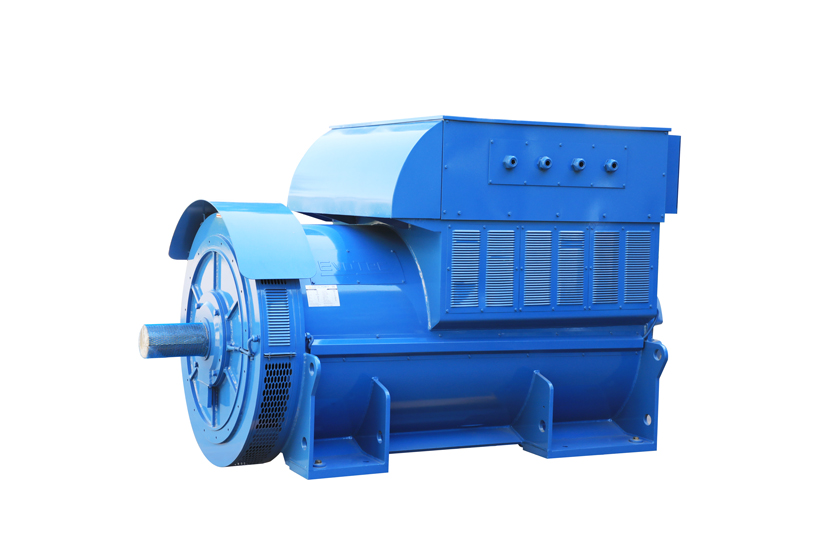Im Bereich der elektrischen Stromerzeugung gelten Drehstromwechselstromgeneratoren als zentrale Komponenten für die Erzeugung zuverlässigen und effizienten Stroms. EvoTec, ein Branchenführer in der Stromerzeugung, hat die Kunst der Generatorenkonstruktion – insbesondere bei Drehstromsynchrongeneratoren – meisterhaft beherrscht. Lassen Sie uns die strukturellen und betrieblichen Prinzipien untersuchen, die die Generatoren von EvoTec Power zu technologischen und effizienten Spitzenreitern machen.

Der Aufbau der EvoTec Power-Drehstromwechselstromgeneratoren
Die Architektur eines Drehstromwechselstromgenerators ist sowohl komplex als auch genial – sie gewährleistet, dass die Leistungsabgabe nicht nur leistungsstark, sondern auch konsistent und zuverlässig ist. Hier die Aufschlüsselung des grundlegenden Aufbaus:
Stator und Spulen
Im Herzen des Drehstromwechselstromgenerators von EvoTec Power liegt der Stator – der stationäre Teil des Generators. Der Statorkern ist mit drei identischen Spulen ausgestattet, die eingebettet und gleichmäßig mit 120 Grad Abstand um den Umfang angeordnet sind. Diese strategische Platzierung sorgt für einen balancierten elektrischen Phasenverlauf und reduziert Vibrationen sowie Harmonische während des Betriebs.
Neutralleiter und Phasenleitungen
Jede Spule im Stator hat zwei Anschlüsse: einen Neutralleiter und einen Phasenleiter. Der Neutralleiter verbindet die drei Spulen zu einem gemeinsamen Nullpunkt, während die Phasenleitungen die Ausgangsanschlüsse sind, die den erzeugten Strom liefern. Diese Konfiguration ist entscheidend für die Stabilität und Verteilung der elektrischen Leistung.
Drehstromspannungen
Das Verständnis der Spannungserzeugung in einem Drehstromsystem ist essenziell, um die Effizienz des EvoTec Power-Designs zu würdigen:
Erzeugung separater Phasen
In einem Drehstromsystem erzeugt jede Spule ihre eigene Spannungsphase. Trotz separater Erzeugung sind die Spannungen in ihrer Größe identisch – dank der einheitlichen Struktur und elektromagnetischen Eigenschaften der Spulen. Die Phasen sind zudem um 120 Grad versetzt, was der physischen Platzierung der Spulen entspricht. Diese Phasenverschiebung ist entscheidend für einen gleichmäßigen und kontinuierlichen Fluss elektrischer Energie.
Faktoren, die die Spannungsgröße beeinflussen
Die Spannungsgröße in jeder Phase wird von mehreren Faktoren bestimmt:
- Rotormagnetfluss: Die Wechselwirkung des Magnetfelds zwischen Rotor und Spulen.
- Phasenleiter: Anzahl und Position der Leiter in jeder Phase.
- Rotordrehzahl: Die Geschwindigkeit, mit der der Rotor dreht – direkt beeinflusst die Frequenz der induzierten Spannung.
Frequenz der induzierten Spannung
Die Frequenz der in jeder Phase erzeugten Spannung ist direkt proportional zur Rotordrehzahl. In den Wechselstromgeneratoren von EvoTec Power – die typischerweise ein zweipoliges Design aufweisen – wird die Frequenz durch die Anzahl der Umdrehungen des Rotors pro Sekunde bestimmt. Diese Beziehung gewährleistet, dass der Generator präzise an spezifische Leistungsanforderungen und Betriebsbedingungen angepasst werden kann.
Innovationen und Varianten von EvoTec Power
Obwohl die Grundprinzipien der Drehstromspannungserzeugung konstant bleiben, innoviert EvoTec stetig, um die Leistung zu verbessern und sich an verschiedene Stromerzeugungsbedürfnisse anzupassen. Variationen in den Generatorentwürfen ermöglichen Anpassungen an verschiedene industrielle Anwendungen, Umgebungsbedingungen und gesetzliche Vorschriften – so stellt jedes Produkt eine optimale Leistung sicher.
Zusammenfassung
Die Drehstromwechselstromgeneratoren von EvoTec Power verkörpern technische Exzellenz, mit Fokus auf Haltbarkeit, Effizienz und Zuverlässigkeit. Das Verständnis der grundlegenden Prinzipien hinter diesen leistungsstarken Maschinen hilft Benutzern, die Komplexität ihrer täglichen Betriebsabläufe und ihre zentrale Rolle in der globalen Stromerzeugung zu würdigen. Ob für kleine Gemeinden oder große Industrieanlagen – die Generatoren von EvoTec Power sind darauf ausgelegt, die Herausforderungen moderner elektrischer Anforderungen zu meistern und eine stabile, effiziente Stromversorgung überall sicherzustellen, wo sie benötigt wird.
